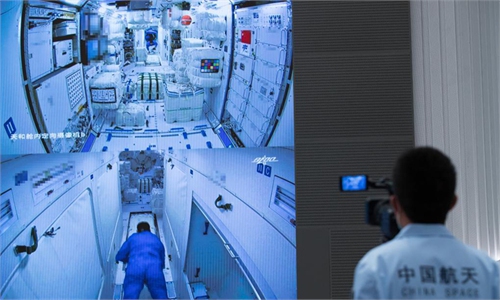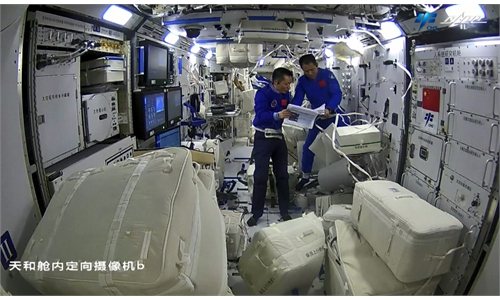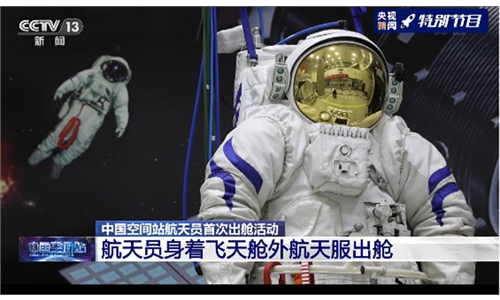SCI-TECH / AIR & SPACE
Taikonauts execute first spacewalk with full success, laying ground for future space station EVA missions
Showcases China mastering all three key manned space technologies
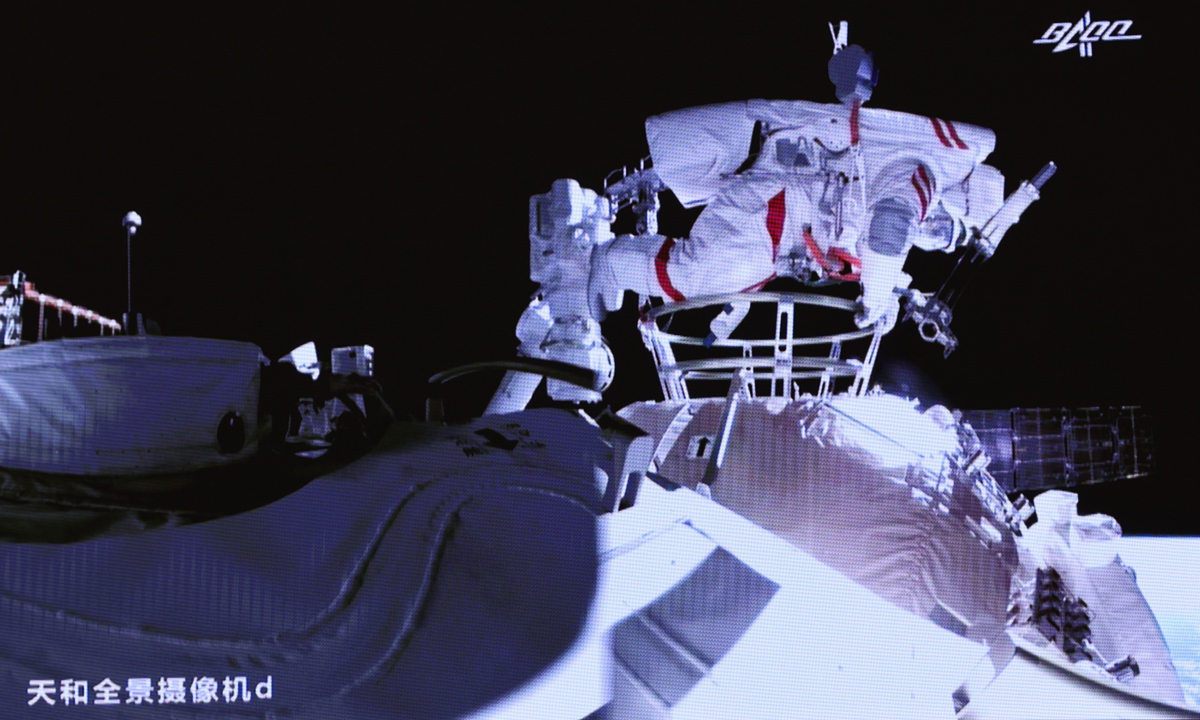
Screen image taken at Beijing Aerospace Control Center on Sunday shows one of the Chinese taikonauts conducting extravehicular activities (EVAs) out of the space station core module Tianhe. Photo: Xinhua
This was what taikonaut Liu Boming said in awe as he moved out of the node cabin of China's Tianhe space station core module at 8:11 am on Sunday, when he embarked on the first extravehicular activity (EVA) for Shenzhou-12, or more commonly known as the spacewalk. This was the second spacewalk in China's aerospace history following the one in the 2008 Shenzhou-7 mission.
Liu is one of the three-member Shenzhou-12 crew currently onboard. By 11:02 am Sunday, his fellow crew member Tang Hongbo also stepped out of the cabin and joined his spacewalking journey with success, the Global Times learned from the China Manned Space Agency (CMSA) on Sunday.
Nie Haisheng, the third taikonaut in the crew and the mission commander, stayed inside the cabin and operated systems onboard the orbiting spacecraft including one for the smart robotic arm, to help and support the two spacewalking taikonauts.
The entire EVA lasted 7 hours, and by 2:57 pm, the two taikonauts safely returned to the Tianhe core module, marking the successful completion of all set task goals of the first spacewalk mission, laying the foundation for a following EVA, the CMSA said.
Liu and Tang had installed foot stops on the robotic arm and working station outside the cabin. And at around 12:09 pm, they lifted the panorama camera outside the Tianhe core module, another major task for their first EVA of the mission.
Due to restrictions at launch, the panorama camera was initially installed at a lower position with a limited view, and the taikonauts' task is to lift it to an angle available to monitor the overall situation outside the cabin, CMSA industry insiders explained with the state broadcaster Central China Television (CCTV) on Sunday.
"It's just like setting up a 'selfie stick' for the camera so that it can shoot better views," the camera's chief designer was quoted as saying in China Space News, the newspaper co-published by China Academy of Space Technology and the China Aerospace Science and Industry Corporation.
The Sunday activity also tested the emergency escape plan, in case taikonauts need to return immediately to the node cabin when they encounter emergency situations during extravehicular operations.
The emergency return drill was carried out by the youngest of the three crew - Tang Hongbo, who is 46 years old and on his first trip to space. After climbing to the farthest point of Tianhe, he rushed back to the cabin gate in the fastest manner upon hearing the command.
The latest progress in the space station mission has drawn waves of admiration from netizens, who have waited 13 years for another grand spacewalk performance after Shenzhou-7's mission in 2008. At least eight related topics topped the most searched bar on China's Twitter-like Sina Weibo on Sunday, attracting some 1 billion views as of press time.
As most netizens showed great respect for the taikonauts, the amazing photos of Earth taken from outside the cabin, the surrounding sky full of stars, and the tacit coordination between the crew and the ground, left stargazers in awe, in laughter, and for some, in tears.
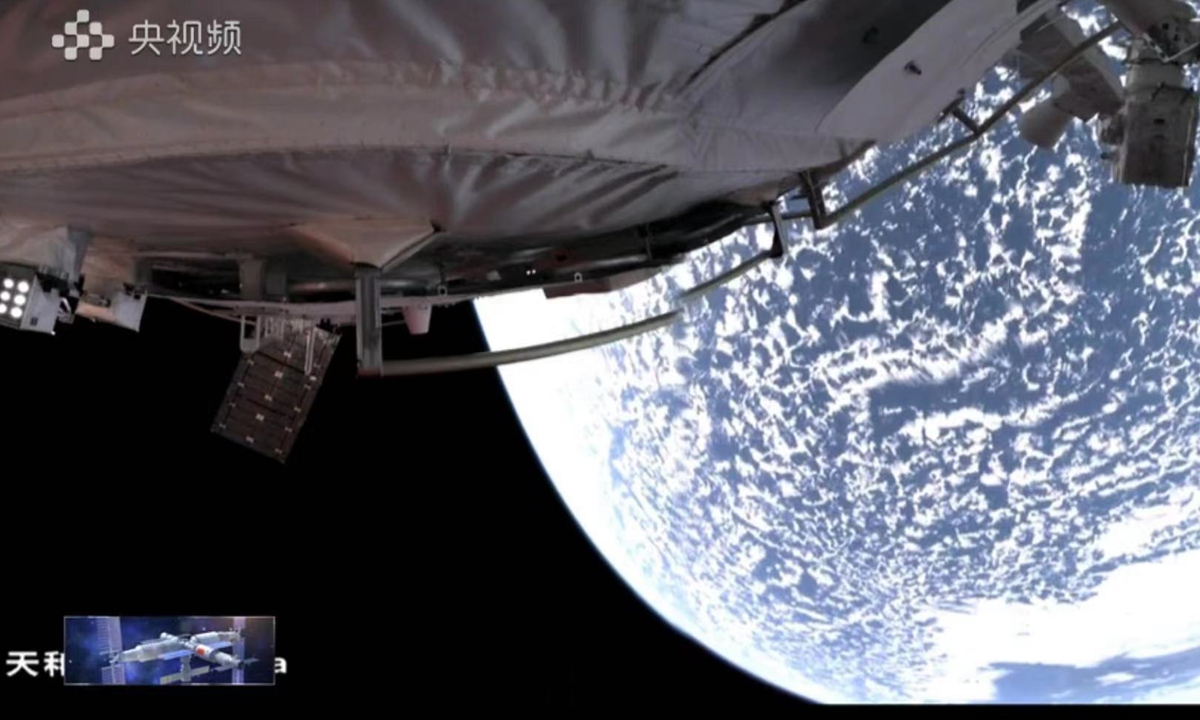
Photo: CGTN
Major stride
Analysts hailed the long-duration spacewalk operation on Sunday as another major stride forward in the country's manned space development. Compared with the spacewalk 13 years ago which lasted only some 20 minutes for the sole purpose of verifying related technology, Sunday's undertaking was more task-oriented.
"It was a milestone that showed China has mastered all three key technological skills required for manned space missions, which are entering space and exiting it, the rendezvous and docking of spacecraft, and the ability to work outside the cabin," Wang Ya'nan, a space analyst and chief editor of Beijing-based Aerospace Knowledge magazine, told the Global Times on Sunday.
According to CCTV on Sunday, Liu took a ride on the smart robotic arm outside the cabin to reach the designated work point after he had installed foot stops on it.
Tang climbed to the working point in a "space spiderman" fashion, the CCTV said.
Space observers said such a design was to verify the actual reliability of both technological paths.
The two taikonauts' extravehicular activities are supported by China's new-generation spacesuit codenamed Feitian, meaning "flying to space," which is designed to fit a taikonaut with a height range between 160-180 centimeters. Although weighing 130 kilograms each, it takes only 3-5 minutes to take it on, researchers explained.
On this special day, the three taikonauts had a rather fancy breakfast to support their high physical exertion, said Yin Rui, deputy chief commander of the astronaut system at CMSA. The meal included flower cakes from Southwest China's Yunnan Province, flavored beef, nuts and chocolates, with a total energy load of about 600 kilocalories.
The Sunday spacewalk conducted by the taikonauts also verified the long-duration life support system of the spacesuit, which has seen great improvements from the one used in the Shenzhou-7 mission.
The new-generation spacesuits separate taikonauts from the complicated space environment and provide them with an environment similar to that on Earth.
On the back of the spacesuits are the portable life support systems suitable under various conditions, providing oxygen and other necessary supplies. The consumption of water and food is also available from a tube on each side of the suit.
The unique robotic arm system was developed by the China Academy of Space Technology (CAST), the main contractor of the space station program.
It is the most complex, and largest in size, mechanical systems in space, with the highest control accuracy, the Global Times learned from CAST on Sunday. The unfolded length of the robotic arms is 10.2 meters, and its maximum loading capacity is 25 tons, capable of moving the space lab modules of the station in the future.
The robotic arms have a total of seven joints imitating the movements of human arms, with three joints on the shoulder, one on the elbow, and three on the wrist, enabling it to grasp or operate from any direction to assist the taikonauts' extravehicular works, as well as the capability to "crawl" outside the space station and reach further scopes.
The system is the country's first such mechanical manipulator that supports long-term durations in orbit, making China the third country in the world to have mastered and applied the technology of large-scale space robotic arms with all core components made domestically, CAST noted.
It is one of many new areas in the aerospace industry that China is developing, according to CAST, having paved a way for more China-made smart manufacturing in space.
Aside from saving astronauts' energy from the arduous climbing process, Wang said the robotic arms would also lower the physical threshold for future non-professional visitors to the space station, such as scientific researchers conducting EVA tasks.
Mission contractor CAST also lauded the successful spacewalk, saying that it would lay the ground for in-orbit support capability for the long-term operation of China's space station.
Another highlight of the Sunday activity that impressed many netizens as they watched the livestreaming video on China's Twitter-like Sina Weibo is the smooth communication between the taikonauts and the ground command center, and the high-resolution footage recording their tasks outside the cabin.
They are supported by a "space network" composed of homegrown Tianlian satellites, and a Wi-Fi service that covers the entire station, including outside, that enables real-time recording of onboard activities.
The downlink rate of the station's space network is 1.2 gigabits per second, which is equivalent to 5G speeds on the ground, and the time delay is merely within 1 second, the system developer previously told CCTV News.
China's space station is expected to become operational by around 2022. When completed, the space station will be able to operate in orbit for at least 10 years, which could be extended to 15 years under proper maintenance, mission designers told the Global Times.
Wang of the Aerospace Knowledge explained that China's innovative design of such a unique robotic arm system with high mobility would assist future spacewalking astronauts in their routine repair and maintenance work, emergency responses as well as expanding and upgrading the space station.
The Shenzhou-12 crew moved into the Tianhe space station core module on June 17 and are currently in good condition. According to the CMSA, they are expected to perform another spacewalk during their stay in orbit.
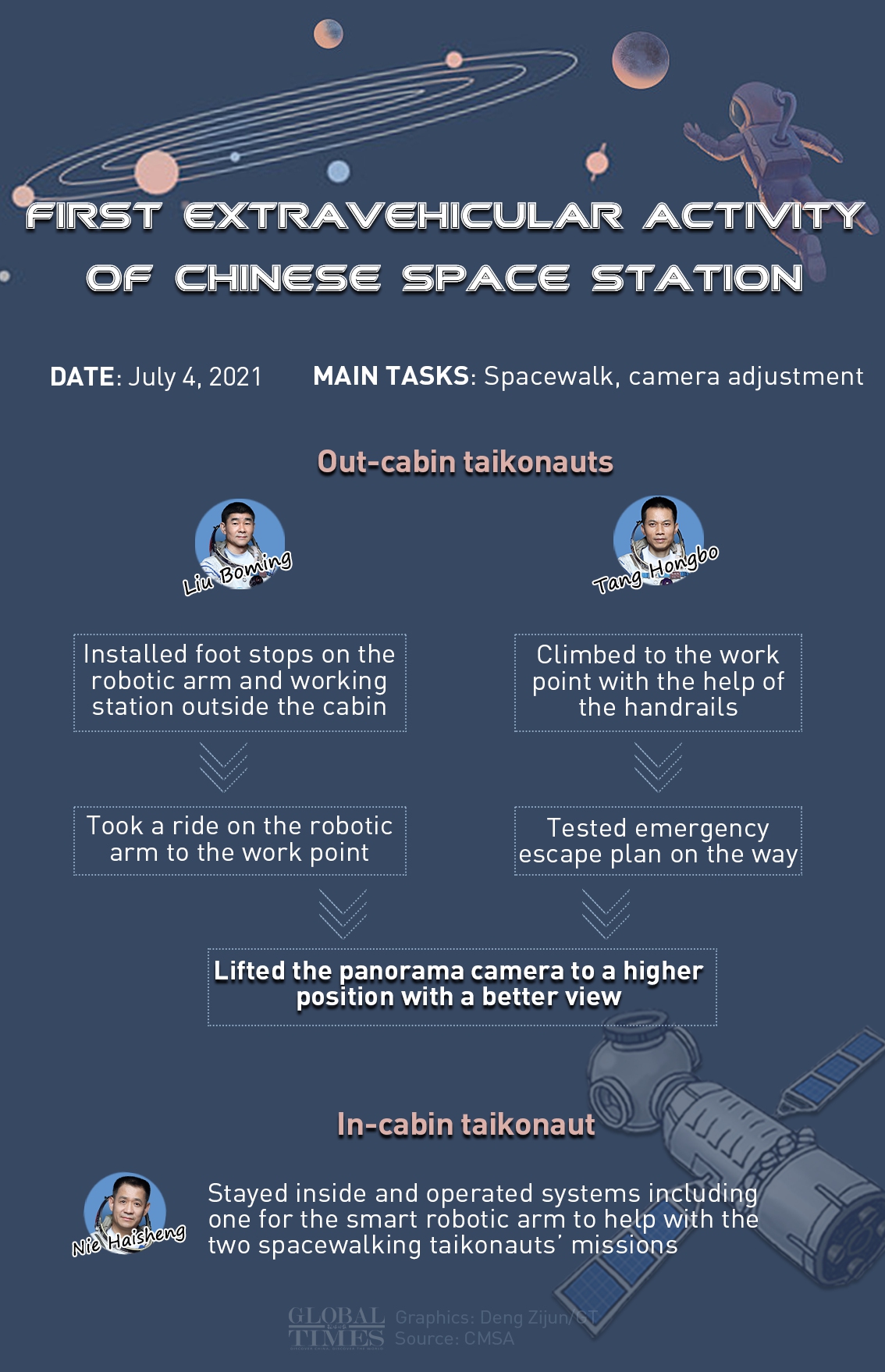
First Extravehicular Activity of Chinese Space Station Infographic: Deng Zijun/GT

